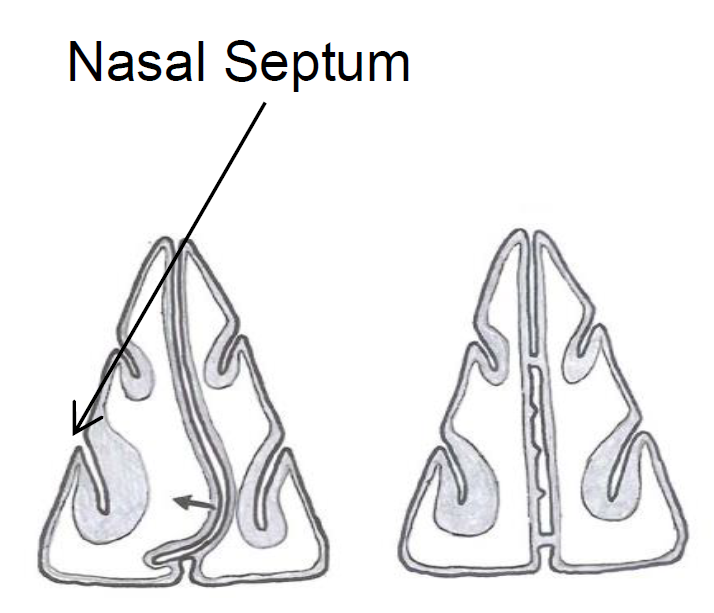Septoplasty
What does the nasal septum do?
The nasal septum is a thin vertical sheet (cartilage at the front and bone further back) which divides the nose into left and right sides.

Why is a septoplasty operation done?
If you have a blocked nose because of a bent nasal septum, the operation would be recommended to make it easier for you to breathe through the nose. The operation is not meant to change the way your nose looks from the outside.
In some patients having surgery to the sinuses we need to straighten the septum to give us room to do the operation.
Sometimes the outside of the nose is bent from a previous injury. In these cases, an operation to straighten the septum may be combined with an operation to straighten the outside of the nose (a septorhinoplasty).
Is there any alternative treatment?
If the main reason for your blocked nose is a bent nasal septum, only an operation will correct this. If the blockage is also being caused by swelling of the lining of the nose, treatment with sprays or drops may help.
How is the operation done?
The operation is done under a full general anaesthetic. It takes about 30 minutes in all. The operation is all done inside the nose, with no swelling or bruising expected on the face.
A cut is made on the septum just inside the nostril, and the soft tissue lining of the septum lifted off. Some of the septum is taken away so that it lies in the midline again, and a couple of dissolving stitches are put into the wound and then perhaps some more dissolving stitches across the septum. We would then probably put a nasal pack into each side of the nose to reduce the chance of bruising into the nasal septum after the operation. The packs will completely block your nose so that you can only breathe through your mouth.
What are the possible complications of the operation?
The operation is done under a general anaesthetic, and all operations under a general anaesthetic carry a small risk. You would be able to discuss this with your anaesthetist.
Sometimes the nose can bleed after the operation. This can happen within a few hours of the operation, or after you have gone home, up to 10 days after the operation. Rarely, you would need to return to theatre and have a second general anaesthetic to stop the bleeding.
Infection in your nose is rare after this type of surgery but can be serious, so you need to see a doctor if your nose is getting more blocked and painful after you have gone home.
Rarely, the operation can leave you with a hole in the nasal septum where the healing process has been incomplete. This can cause a whistling noise when you breathe, as well as crusting in the nose and nosebleeds. Mostly this will cause no problems at all, but it may be noted at your first postoperative review appointment.
Scarring across from the septum to the side wall of the nose can occur after nose operations – an adhesion – and this can cause some blockage, but may cause no symptoms at all.
Rarely, the external shape of the nose will change with a dip in the bridge of the nose, perhaps months after the operation. This would be more likely if there has been an infection.
Very rarely you can have numbness of the middle teeth at the top which will usually settle with time.
Very rarely there can be a loss of your sense of smell and taste after the operation.
Before the operation
Arrange for two weeks off work.
Check that you have a friend or relative who can take you home after the operation as you must not drive for at least 24 hours after a general anaesthetic.
Make sure that you have a supply of simple painkillers at home.
After the operation
We may give you some drops or a spray after the operation to use at home. Try to stay away from dusty or smoky atmospheres. Expect the nose to be blocked and wet for a couple of weeks like a head cold, and then to dry up but remain blocked for a few more weeks. It may take two to three months to settle down from the surgery.
Do not blow your nose for about a week. If you are going to sneeze, sneeze with your mouth open to protect the nose. Some blood stained discharge from the nose is normal for the first week or two.
Where can I find out more about the operation?
We would recommend the ENT UK website for information about septal surgery and rhinoplasty: www.entuk.org
If you have any questions about general anaesthetics, the Royal College of Anaesthetists website has a lot of information: www.rcoa.ac.uk/patientinfo
The Royal College of Surgeons also have information about recovery from a septoplasty: www.rcseng.ac.uk
Useful contact numbers
Dorset County Hospital Switchboard – 01305 251150
ENT secretaries (Dorchester)
Mr Ford 01305 255138
Mr Tsirves 01305 253167
Mr De Zoysa 01305 255138
Mr Sim 01305 254205
Mr Lale 01305 255510
Mr Kenway 01305 255138
Mr Chatzimichalis 01305 255510
ENT secretaries (Yeovil)
01935 384210
About this leaflet
Author: Mr Glen Ford, ENT Consultant
Reviewed by: Mr Bruno Kenway, ENT Consultant, March 2020
Approved: August 2020
Review date: August 2023
Edition: 2
If you have feedback regarding the accuracy of the information contained in this leaflet, or if you would like a list of references used to develop this leaflet, please email patientinformation.leaflets@dchft.nhs.uk
Print leaflet